ECO mode Citroen C4 PICASSO 2016 2.G Owner's Guide
[x] Cancel search | Manufacturer: CITROEN, Model Year: 2016, Model line: C4 PICASSO, Model: Citroen C4 PICASSO 2016 2.GPages: 527, PDF Size: 13.72 MB
Page 156 of 527
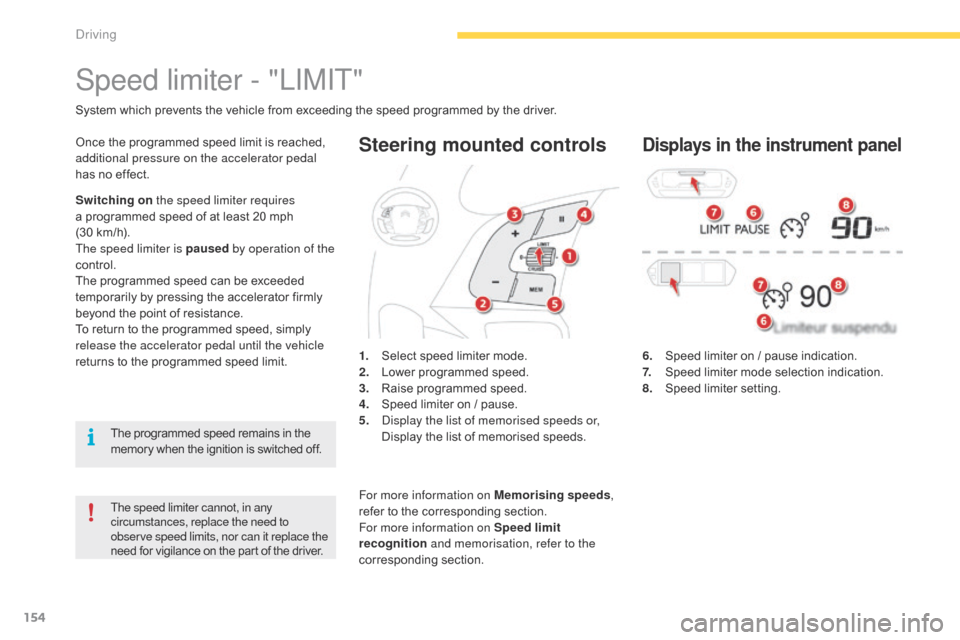
154
C4-Picasso-II_en_Chap04_conduite_ed01-2016
Steering mounted controls
6. Speed limiter on / pause indication.
7. S peed limiter mode selection indication.
8.
S
peed limiter setting.
Speed limiter - "LIMIT"
System which prevents the vehicle from exceeding the speed programmed by the driver.
The speed limiter cannot, in any
circumstances, replace the need to
observe speed limits, nor can it replace the
need
for vigilance on the part of the driver.
Once the programmed speed limit is reached, additional pressure on the accelerator pedal
has
no effect.
1.
S
elect speed limiter mode.
2.
L
ower programmed speed.
3.
R
aise programmed speed.
4.
S
peed limiter on / pause.
5.
D
isplay the list of memorised speeds or,
D
isplay the list of memorised speeds.Displays in the instrument panel
Switching on the speed limiter requires
a programmed speed of at least 20 mph
(
30 km/h).
The speed limiter is paused by operation of the
control.
The
programmed speed can be exceeded
t
emporarily by pressing the accelerator firmly
b
eyond the point of resistance.
To
return to the programmed speed, simply
r
elease the accelerator pedal until the vehicle
returns
to the programmed speed limit.
The
programmed speed remains in the
m
emory when the ignition is switched off.For more information on Memorising speeds ,
refer
to the corresponding section.
For more information on Speed limit
recognition and memorisation, refer to the
corresponding
s
ection.
Driving
Page 157 of 527
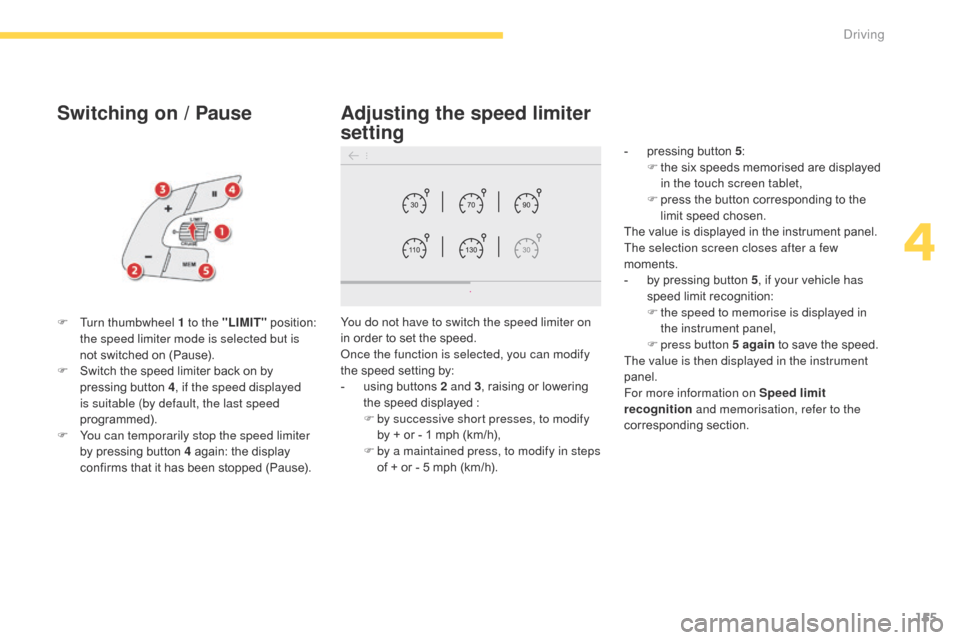
155
C4-Picasso-II_en_Chap04_conduite_ed01-2016
Switching on / Pause
F Turn thumbwheel 1 to the "LIMIT" position: t
he speed limiter mode is selected but is
not
switched on (Pause).
F
S
witch the speed limiter back on by
p
ressing button 4, if the speed displayed
is suitable (by default, the last speed
programmed).
F
Y
ou can temporarily stop the speed limiter
by
pressing button 4 again: the display
c
onfirms that it has been stopped (Pause).You do not have to switch the speed limiter on
in
order to set the speed.
Once the function is selected, you can modify
the
speed setting by:
-
u
sing buttons 2 and 3,
raising or lowering
t
he speed displayed :
F
b
y successive short presses, to modify
by
+ or - 1 mph (km/h),
F
b
y a maintained press, to modify in steps
of
+ or - 5 mph (km/h).
Adjusting the speed limiter
setting
- pressing button 5:
F t he six speeds memorised are displayed
i
n the touch screen tablet,
F
p
ress the button corresponding to the
l
imit speed chosen.
The
value is displayed in the instrument panel.
The selection screen closes after a few
moments.
-
b
y pressing button 5, if your vehicle has
speed
limit recognition:
F
t
he speed to memorise is displayed in
the instrument panel,
F
press button 5 again
to save the speed.
The value is then displayed in the instrument
panel.
For more information on Speed limit
recognition and memorisation, refer to the
corresponding
s
ection.
4
Driving
Page 159 of 527

157
C4-Picasso-II_en_Chap04_conduite_ed01-2016
Steering mounted controls
6. Cruise control pause / resume indication.
7. C ruise control mode selection indication.
8.
Spe
ed
s
etting.
Cruise control - "CRUISE"
System which automatically maintains the speed of the vehicle at the value programmed by the driver, without any action on the accelerator pedal.
The cruise control system cannot, in any circumstances, replace the need to observe speed limits, nor can it replace the need for vigilance on the part of the driver.
Y ou are advised to keep your feet near the pedals at all times.
Switching on the cruise control requires a
minimum vehicle speed of 25 mph (40 km/h).
As
well as engagement of:
-
f
ourth gear or higher on a manual gearbox,
-
s
econd gear or higher in manual mode on
a
n automatic gearbox,
-
position D
on an automatic gearbox.
The
system remains active after changing gear
o
n vehicles with a manual gearbox and
Stop
& Start.
The cruise control is paused
by pressing
b
utton 4 or the brake pedal or on triggering of
t
he ESC system for safety reasons.
It
is possible to exceed the programmed speed
t
emporarily by pressing the accelerator pedal.
To
return to the programmed speed, simply
r
elease the accelerator pedal until the
programmed
cruise speed is reached again.1.
S
elect cruise control mode.
2.
S
et the current speed of the vehicle
as
the programmed speed / Lower the
pro
grammed
s
peed.
3.
S
et the current speed of the vehicle
as
the programmed speed / Raise the
pro
grammed
s
peed.
4.
P
ause / resume cruise control.
5.
D
isplay the list of memorised speeds or,
A
ccept the speed suggested by the speed
l
imit recognition system.Displays in the instrument panel
Switching off the ignition cancels any programmed speed value. For more information on Memorising speeds
,
refer to the corresponding section.
For more information on Speed limit
recognition and memorisation, refer to the
corresponding
s
ection.
4
Driving
Page 160 of 527
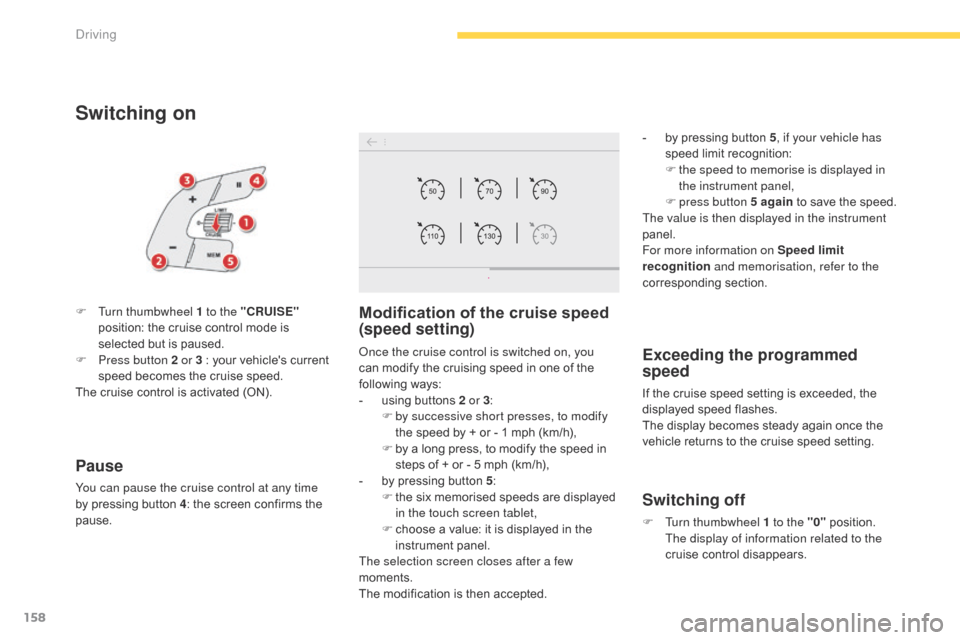
158
C4-Picasso-II_en_Chap04_conduite_ed01-2016
Exceeding the programmed
speed
If the cruise speed setting is exceeded, the displayed speed flashes.
The
display becomes steady again once the
v
ehicle returns to the cruise speed setting.
Switching off
F Turn thumbwheel 1 to the "0" p osition. T
he display of information related to the
cruise
control disappears.
Switching on
Once the cruise control is switched on, you
can modify the cruising speed in one of the
f
ollowing
w
ays:
-
u
sing buttons 2 or 3:
F
b
y successive short presses, to modify
the
speed by + or - 1 mph (km/h),
F
b
y a long press, to modify the speed in
s
teps of + or - 5 mph (km/h),
-
b
y pressing button 5:
F
t
he six memorised speeds are displayed
i
n the touch screen tablet,
F
c
hoose a value: it is displayed in the
in
strument
pan
el.
The selection screen closes after a few
moments.
The
modification is then accepted.
F
T
urn thumbwheel 1 to the "CRUISE"
position:
the
cruise
control
mode
is
s
elected
but
is
paused.
F
P
ress button 2 or 3 :
your
vehicle's
current
s
peed
becomes
the
cruise
speed.
The
cruise
control
is
activated
(ON).
Modification of the cruise speed
(speed setting)
- by pressing button 5, if your vehicle has
speed limit recognition:
F
t
he speed to memorise is displayed in
the instrument panel,
F
press button 5 again
to save the speed.
The value is then displayed in the instrument
panel.
For more information on Speed limit
recognition and memorisation, refer to the
corresponding
s
ection.
Pause
You can pause the cruise control at any time
by pressing button 4:
the screen confirms the
pa
use.
Driving
Page 163 of 527

161
C4-Picasso-II_en_Chap04_conduite_ed01-2016
The dynamic cruise control is switched on
manually: it requires that the speed of the
v
ehicle be between 25 and 90 mph (40 and
150 km/h),
as well as the engagement of:
-
f
ourth gear or higher with a manual
g
earbox,
-
s
econd gear or higher with an automatic
g
earbox in manual mode,
-
position D
with an automatic gearbox.
The
system remains active after changing gear
o
n vehicles with a manual gearbox and
Stop
& Start.
General points
The dynamic cruise control can be paused
manually o r a utomatically:
-
b
y pressing button 4,
-
b
y pressing the brake pedal,
-
i
n the event of operation of the ESC, for
safety reasons,
-
i
n the event of operation of the electric
parking
brake control lever,
-
w
hen an inter-vehicle time threshold is
reached
(calculated according to the
r
elative speeds of your vehicle and the
vehicle in front and the inter-vehicle time
setting
c
hosen),
-
w
hen the distance between your vehicle
and the one in front becomes too small,
-
w
hen the speed of the vehicle in front is too
low,
-
w
hen the speed of your vehicle becomes
too
low.
The dynamic cruise control cannot in any
circumstances replace the observation
of
sp
eed
l
imits,
n
or
t
he
n
eed
fo
r
v
igilance
o
n
the
part
of
the
driver.
It
is
recommended
that
you
always
keep
y
our
feet
close
to
the
pedals.
If
the
speed
setting
selected
is
above
9
0
mph
(150
km/h),
the
system
switches
t
o standard cruise control operation,
with
no
adjustment
of
the
inter-vehicle
s
afe
distance
(a
message
appears
in
t
he
instrument
panel). The
inter-vehicle time setting is kept in
m
emory on switching off the ignition.
The dynamic cruise control operates by
day
and
at
night,
in
fog
or
in
moderate
r
ainfall.
The system does not act on the braking s ystem, but works only with engine braking.
The
regulation range is limited: there will
n
o longer be any adjustment of speed if the
d
ifference between the programmed speed
s
etting and the speed of the vehicle in front
b
ecomes too high (18 mph (30 km/h)).
If the difference between the
programmed speed setting and the
s
peed of the vehicle in front is too
great,
the speed cannot be adjusted:
t
he cruise control is automatically
deactivated.
4
Driving
Page 164 of 527
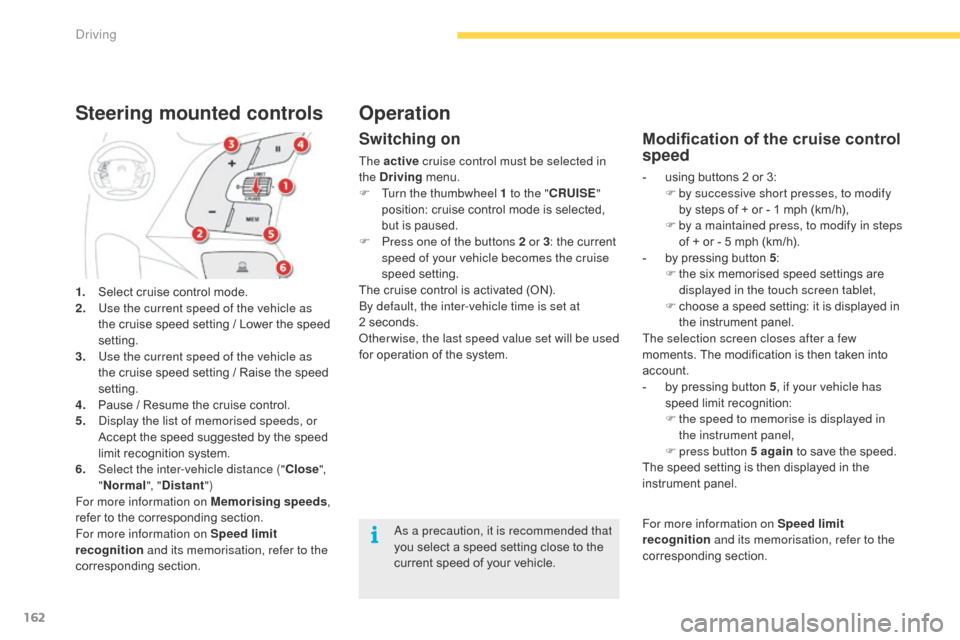
162
C4-Picasso-II_en_Chap04_conduite_ed01-2016
1. Select cruise control mode.
2. U se the current speed of the vehicle as
the
cruise speed setting / Lower the speed
se
tting.
3.
U
se the current speed of the vehicle as
the
cruise speed setting / Raise the speed
se
tting.
4.
P
ause / Resume the cruise control.
5.
D
isplay the list of memorised speeds, or
A
ccept the speed suggested by the speed
l
imit recognition system.
6.
S
elect the inter-vehicle distance (" Close",
" Normal ", "Distant ")
For more information on Memorising speeds ,
refer
to the corresponding section.
For more information on Speed limit
recognition and its memorisation, refer to the
corresponding
s
ection.
Steering mounted controls
Switching on
The active cruise control must be selected in
the Driving menu.
F
T
urn the thumbwheel 1 to the " CRUISE"
position:
cruise control mode is selected,
b
ut is paused.
F
P
ress one of the buttons 2 or 3 :
the current
s
peed of your vehicle becomes the cruise
speed
setting.
The
cruise control is activated (ON).
By default, the inter-vehicle time is set at
2 seconds.
Other wise, the last speed value set will be used
for
operation of the system.
Modification of the cruise control
speed
- using buttons 2 or 3:
F b y successive short presses, to modify
by
steps of + or - 1 mph (km/h),
F
b
y a maintained press, to modify in steps
of
+ or - 5 mph (km/h).
-
b
y pressing button 5:
F
t
he six memorised speed settings are
d
isplayed in the touch screen tablet,
F
c
hoose a speed setting: it is displayed in
t
he instrument panel.
The selection screen closes after a few
moments.
The modification is then taken into
a
ccount.
-
b
y pressing button 5, if your vehicle has
speed
limit recognition:
F
t
he speed to memorise is displayed in
the instrument panel,
F
press button 5 again
to save the speed.
The
speed setting is then displayed in the
in
strument
pan
el.
As a precaution, it is recommended that
you
select
a
speed
setting
close
to
the
c
urrent
speed
of
your
vehicle.
Operation
For more information on Speed limit
recognition and its memorisation, refer to the
corresponding
s
ection.
Driving
Page 170 of 527
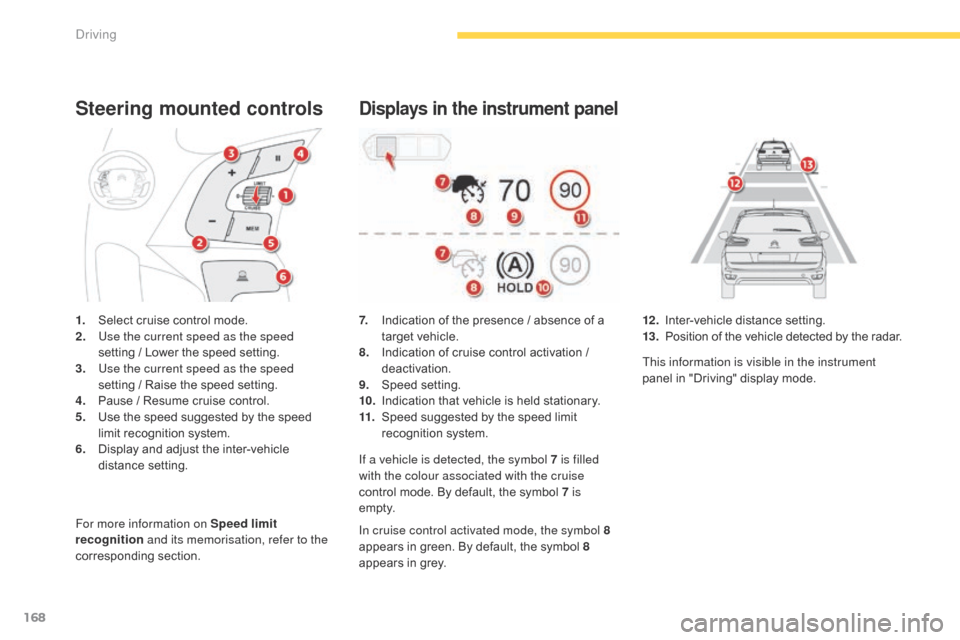
168
C4-Picasso-II_en_Chap04_conduite_ed01-2016
Steering mounted controls
1. Select cruise control mode.
2. U se the current speed as the speed
setting /
Lower the speed setting.
3.
U
se the current speed as the speed
setting /
Raise the speed setting.
4.
P
ause / Resume cruise control.
5.
U
se the speed suggested by the speed
l
imit recognition system.
6.
D
isplay and adjust the inter-vehicle
d
istance
s
etting.
For more information on Speed limit
recognition and its memorisation, refer to the
corresponding
s
ection.
Displays in the instrument panel
7. Indication of the presence / absence of a t
arget vehicle.
8.
I
ndication of cruise control activation /
d
eactivation.
9.
Spe
ed
s
etting.
10.
I
ndication that vehicle is held stationary.
11.
S
peed suggested by the speed limit
r
ecognition system.
If a vehicle is detected, the symbol 7
is filled
with the colour associated with the cruise
control
mode. By default, the symbol 7 is
e m pt y.
In cruise control activated mode, the symbol
8
appears
in green. By default, the symbol 8
appears
in grey. 12 . I
nter-vehicle d istance se tting.
13. P osition of the vehicle detected by the radar.
This information is visible in the instrument
panel
in "Driving" display mode.
Driving
Page 174 of 527
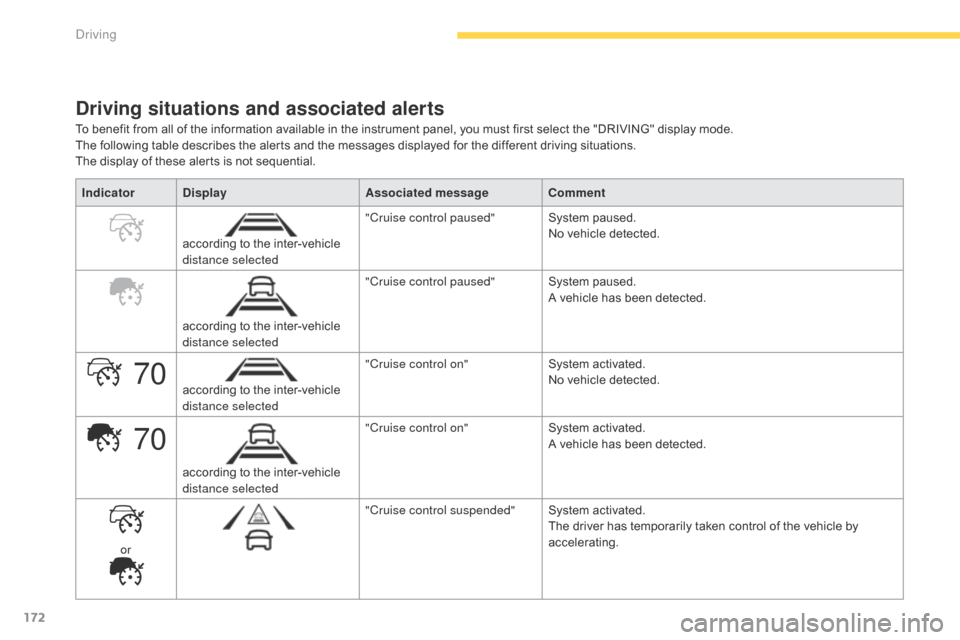
172
70
70
C4-Picasso-II_en_Chap04_conduite_ed01-2016
Driving situations and associated alerts
To benefit from all of the information available in the instrument panel, you must first select the "DRIVING" display mode.
T he following table describes the alerts and the messages displayed for the different driving situations.
The
display of these alerts is not sequential.
Indicator Display Associated messageComment
according
to the inter-vehicle
d
istance selected "Cruise control paused"
System
paused.
No
vehicle detected.
according
to the inter-vehicle
d
istance selected "Cruise control paused"
System
paused.
A
vehicle has been detected.
according
to the inter-vehicle
d
istance selected "Cruise control on"
System
a
ctivated.
No
vehicle detected.
according
to the inter-vehicle
d
istance selected "Cruise control on"
System
a
ctivated.
A
vehicle has been detected.
or "Cruise control suspended"
System
a
ctivated.
The
driver has temporarily taken control of the vehicle by
a
ccelerating.
Driving
Page 177 of 527
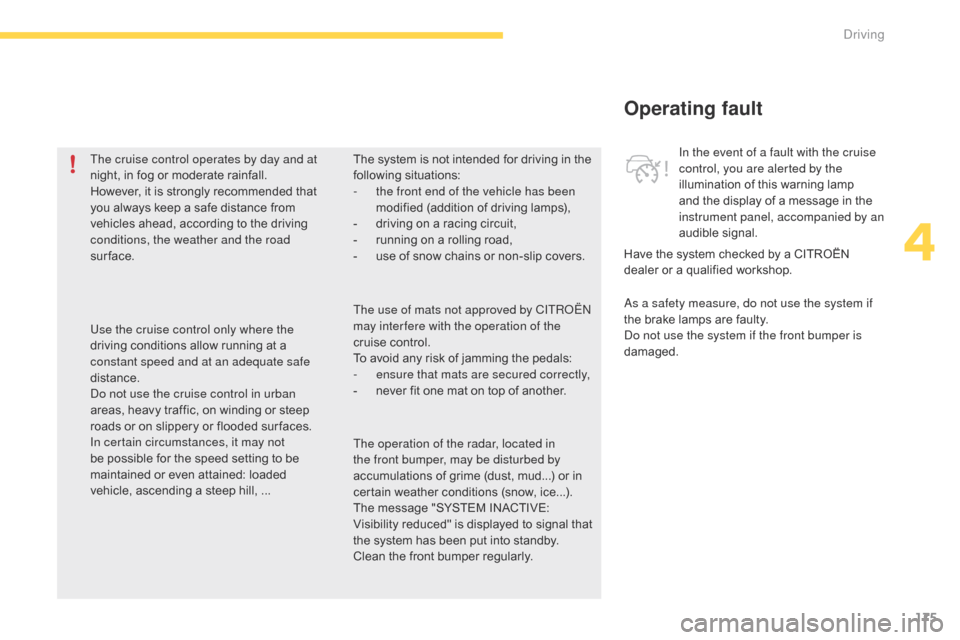
175
C4-Picasso-II_en_Chap04_conduite_ed01-2016
Operating fault
As a safety measure, do not use the system if
the brake lamps are faulty.
Do not use the system if the front bumper is
damaged. In the event of a fault with the cruise
control, you are alerted by the
illumination
of this warning lamp
a
nd the display of a message in the
in
strument panel, accompanied by an
audible
s
ignal.
The cruise control operates by day and at
night,
in
fog
or
moderate
rainfall.
However,
it
is
strongly
recommended
that
y
ou
always
keep
a
safe
distance
from
v
ehicles
ahead,
according
to
the
driving
c
onditions, the weather and the road
sur face.
Use the cruise control only where the
driving
conditions
allow
running
at
a
c
onstant speed and at an adequate safe
distance.
Do not use the cruise control in urban
areas,
heavy
traffic,
on
winding
or
steep
r
oads
or
on
slippery
or
flooded
sur faces.
In certain circumstances, it may not
be
possible
for
the
speed
setting
to
be
m
aintained
or
even
attained:
loaded
v
ehicle,
ascending
a
steep
hill,
... The
system
is
not
intended
for
driving
in
the
fo
llowing
s
ituations:
-
t
he front end of the vehicle has been
modified
(addition
of
driving
lamps),
-
d
riving
on
a
racing
circuit,
-
r
unning
on
a
rolling
road,
-
u
se
of
snow
chains
or
non-slip
covers.
Have the system checked by a CITROËN
d
ealer or a qualified workshop.
The operation of the radar, located in
the front bumper, may be disturbed by
accumulations
of
grime
(dust,
mud...)
or
in
c
ertain
weather
conditions
(snow,
ice...).
The
message
"SYSTEM
INACTIVE:
V
isibility
reduced"
is
displayed
to
signal
that
t
he
system
has
been
put
into
standby.
Clean
the
front
bumper
regularly.
The use of mats not approved by CITROËN
may inter fere with the operation of the
cruise
control.
To
avoid
any
risk
of
jamming
the
pedals:
-
e
nsure that mats are secured correctly,
-
n
ever
fit
one
mat
on
top
of
another.
4
Driving
Page 182 of 527
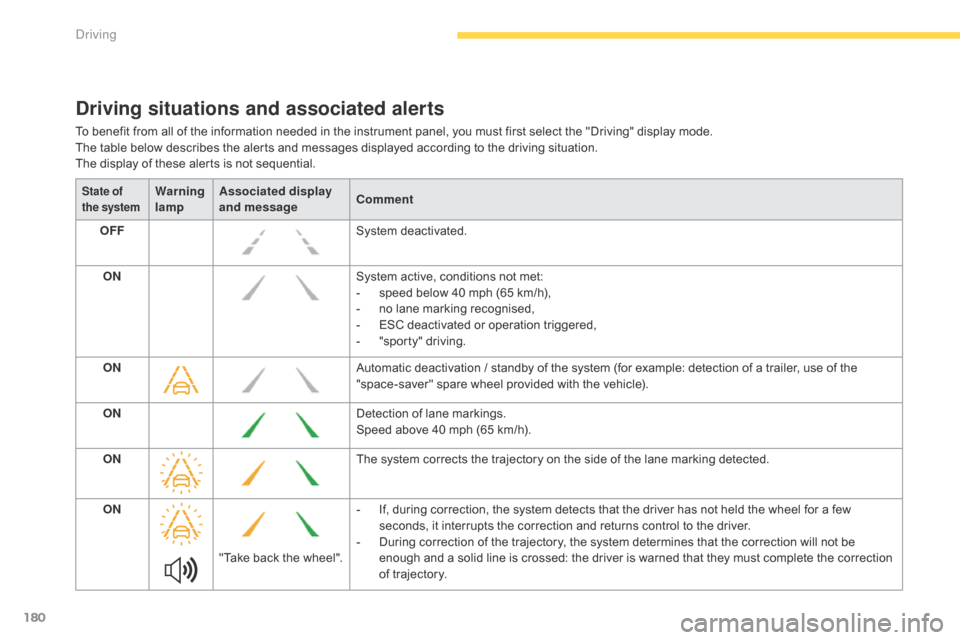
180
C4-Picasso-II_en_Chap04_conduite_ed01-2016
Driving situations and associated alerts
To benefit from all of the information needed in the instrument panel, you must first select the "Driving" display mode.
T he table below describes the alerts and messages displayed according to the driving situation.
The
display of these alerts is not sequential.
State of
the systemWarning
lamp Associated display
and message
Comment
OFF System
d
eactivated.
ON System
active, conditions not met:
-
s
peed below 40 mph (65 km/h),
-
n
o lane marking recognised,
-
ES
C deactivated or operation triggered,
-
"
sporty" driving.
ON Automatic
deactivation / standby of the system (for example: detection of a trailer, use of the
"
space-saver" spare wheel provided with the vehicle).
ON Detection
of lane markings.
Speed
above 40 mph (65 km/h).
ON The
system corrects the trajectory on the side of the lane marking detected.
ON "Take
back the wheel".-
I
f, during correction, the system detects that the driver has not held the wheel for a few
s
econds, it interrupts the correction and returns control to the driver.
-
D
uring correction of the trajectory, the system determines that the correction will not be
e
nough and a solid line is crossed: the driver is warned that they must complete the correction
o
f trajectory.
Driving